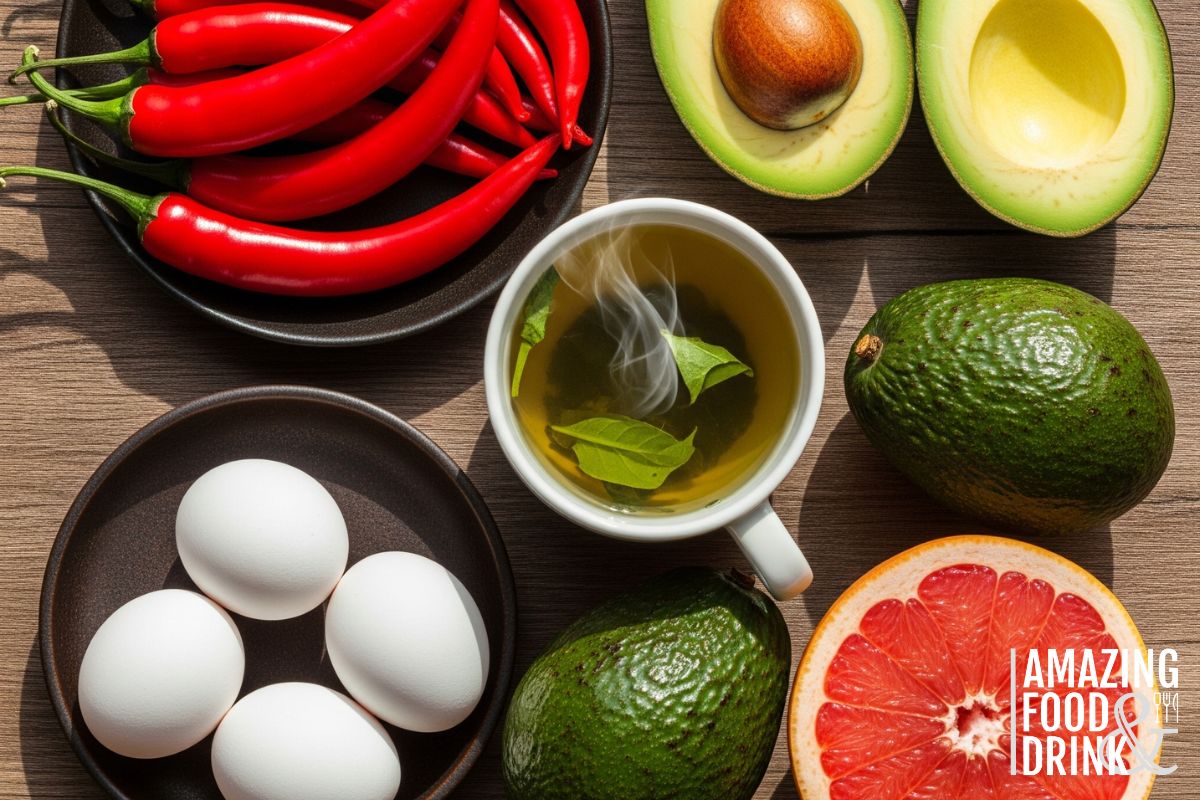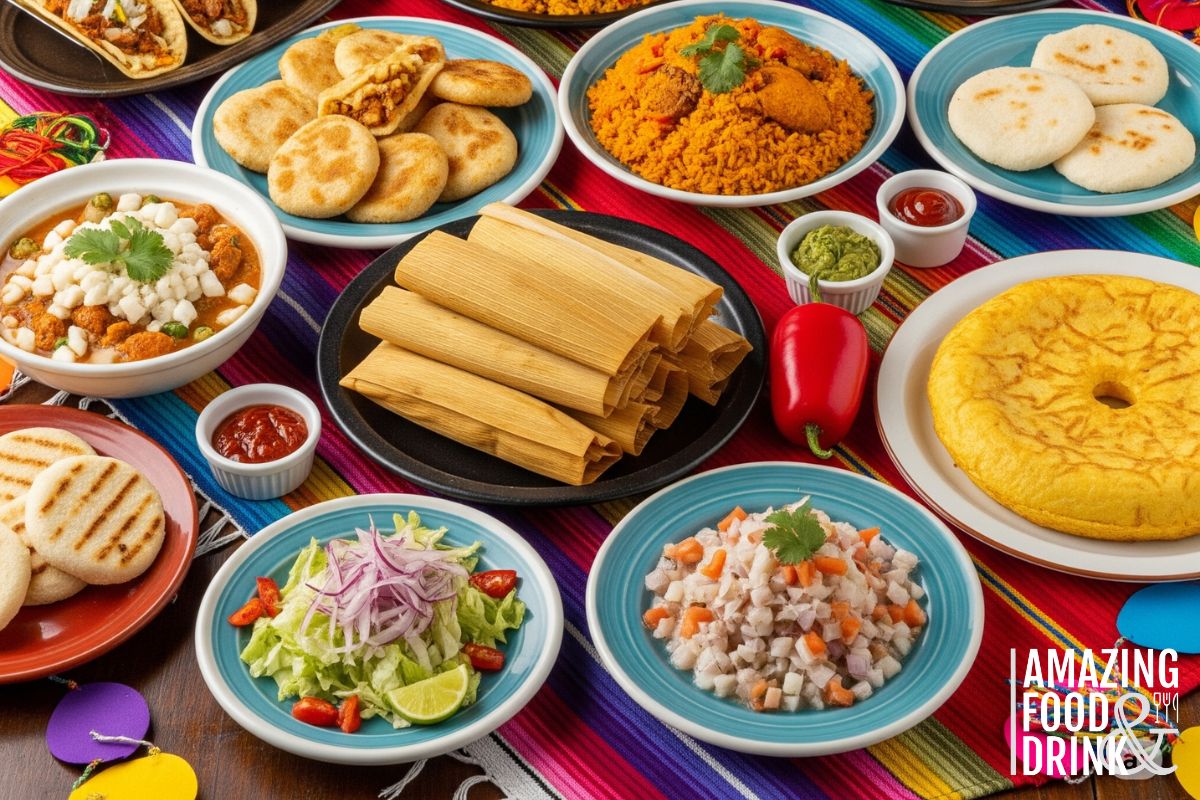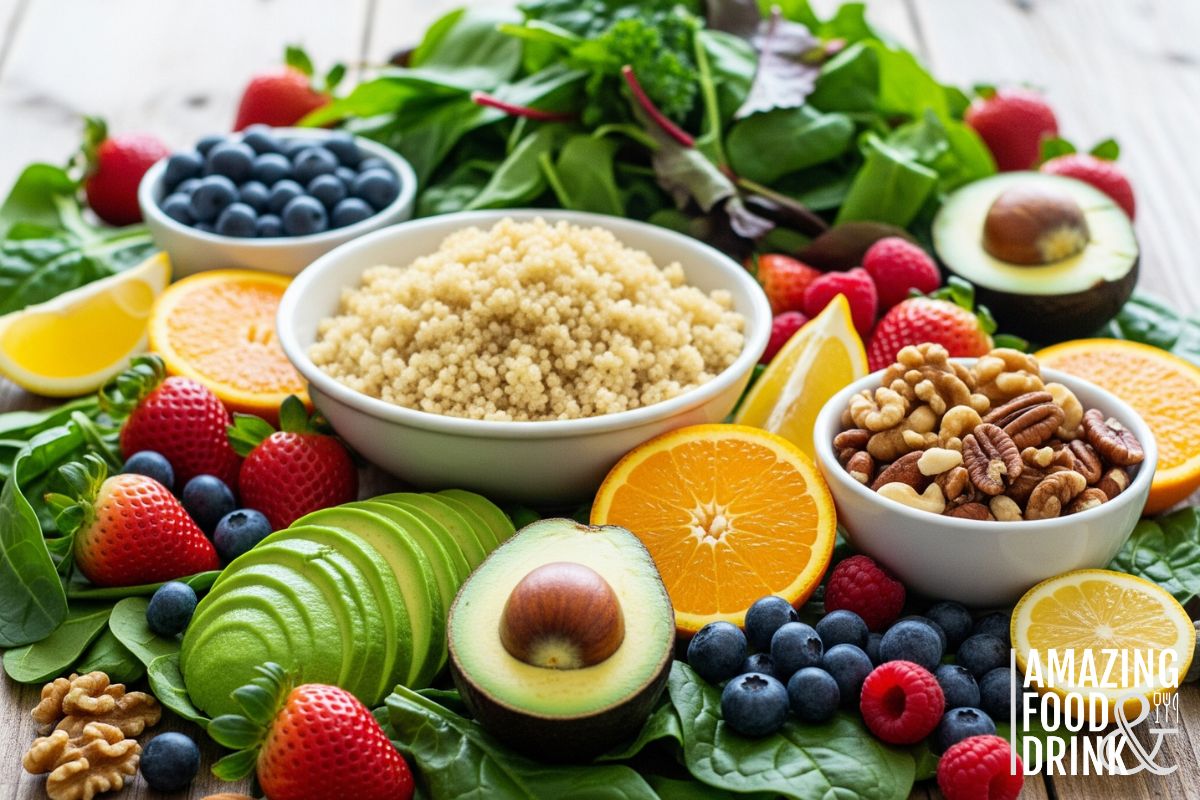Metabolism boosting doesn’t have to be complicated. Whether you’re looking to boost your metabolism for weight loss, increased energy, or overall health, the foods you choose play a crucial role in how efficiently your body burns calories. Understanding which foods support your metabolic rate and which ones slow it down is essential for maintaining a healthy lifestyle.
Your metabolism is the complex process by which your body converts food and oxygen into energy. This intricate system determines how many calories you burn at rest and during activity. The good news? You can naturally increase metabolism through strategic food choices and simple lifestyle changes.
This comprehensive guide will explore the best and worst foods for metabolism, practical habits that speed up your metabolic rate, and answer the most common questions about metabolism-boosting foods. By the end, you’ll have all the tools to support your body’s natural fat-burning processes.
Table of Contents
Best Metabolism Boosting Foods

Discover the most powerful foods that can increase your metabolic rate by up to 30% and help you burn more calories throughout the day. These scientifically proven metabolism-boosting foods increase your body’s thermic effect, turning your digestive system into a calorie-burning machine.
The right foods can significantly impact your metabolic rate, helping you burn more calories throughout the day. These metabolism-boosting foods increase the thermic effect of food (TEF), which is the energy required to digest, absorb, and process nutrients.
Top 10 Metabolism-Boosting Foods (Ranked by Effectiveness)
The most effective metabolism-boosting foods are lean chicken breast and salmon. Due to their high protein content and omega-3 fatty acids, they top the list with a 20-30% metabolic boost, burning 25-30 and 22-28 calories per 100g, respectively.
Greek yoghurt and eggs follow closely, increasing 15-22% due to their complete protein profiles and additional nutrients like probiotics and essential amino acids.
According to research published in the American Journal of Clinical Nutrition, chilli peppers earn their place with an impressive 8-10% metabolic boost from capsaicin. They burn 15-20 calories per 100g while also suppressing appetite.
Almonds and broccoli offer sustained benefits with 8-15% increases. They combine healthy fats, protein, and high fibre content that require significant digestive energy.
Green tea provides a 4-8% boost through its unique combination of caffeine and catechins, burning 10-15 calories per 100g whilst supporting fat oxidation, as demonstrated in multiple clinical studies.
Spinach and black coffee round out the top 10. Spinach offers an 8-10% increase through its iron content and nutrient density, while black coffee delivers a pure 5-10% caffeine-driven metabolic boost that can burn 8-15 calories per 100g when consumed without added sugars or cream.
Key Categories of Metabolism-Boosting Foods

Understanding the science behind different food categories helps you make strategic choices for maximum metabolic impact. Each category uses unique mechanisms to increase calorie burn and support long-term weight management.
Protein-Rich Foods for Metabolism
Protein is the ultimate metabolism-boosting macronutrient, requiring up to 30% more energy to digest than carbs or fats. This powerful thermic effect makes protein-rich foods your best allies for burning calories around the clock.
Protein is the most effective macronutrient for boosting metabolism. Foods that boost metabolism through protein include lean meats, fish, eggs, and dairy products. When you consume protein, your body burns up to 30% more calories during digestion than carbohydrates or fats.
Top protein sources for metabolism:
- Chicken breast and lean beef
- Salmon and other fatty fish
- Eggs (particularly egg whites)
- Greek yoghurt and cottage cheese
- Legumes and lentils
Protein is so effective at boosting metabolism because of its thermic effect, scientifically known as diet-induced thermogenesis. According to research published in the Journal of the American College of Nutrition, your body works harder to break down protein molecules, naturally increasing your metabolic rate for several hours after eating. This process can increase your resting metabolic rate by 15-30% for up to 6 hours post-meal.
Spicy Foods That Increase Metabolism Naturally
Spicy foods containing capsaicin, which gives chilli peppers their heat, can temporarily boost your metabolism by up to 8%. This metabolism and weight loss connection makes spicy foods an excellent addition to your diet.
Best spicy foods for metabolism:
- Jalapeño peppers
- Cayenne pepper
- Chilli powder
- Hot sauce (without added sugars)
- Fresh chillies
The metabolic boost from spicy foods is temporary but can contribute to overall calorie burn when consumed regularly. Additionally, capsaicin may help suppress appetite, supporting your weight management goals.
Caffeinated Beverages for Metabolic Support
Caffeine is a well-researched metabolism booster that can increase your metabolic rate by 3-11%. The best caffeinated options for metabolism include:
Green tea contains both caffeine and catechins, powerful antioxidants that synergistically boost metabolism. Studies published in the International Journal of Obesity show that when consumed regularly, green tea can increase fat oxidation by up to 17% and boost metabolic rate by 4-8%.
Coffee (black, without added sugars or cream) provides a significant metabolic boost, particularly when consumed before exercise. Research from the European Journal of Clinical Nutrition demonstrates that caffeine can increase metabolic rate by 3-11% for up to 3 hours post-consumption. The key is avoiding high-calorie additions that can counteract the metabolic benefits.
Pro Tip: Combine green tea with lemon for enhanced catechin absorption, or try matcha for a concentrated dose of metabolism-boosting compounds.
High-Fibre Foods That Speed Up Metabolism
Foods high in fibre, which require more energy to digest, are good for improving metabolism. This increased energy expenditure can boost your metabolic rate by up to 10%.
Best high-fibre foods for metabolism:
- Oats and quinoa
- Broccoli and Brussels sprouts
- Apples and pears
- Almonds and other nuts
- Beans and lentils
- Berries (raspberries, blackberries)
Fibre-rich foods also help regulate blood sugar levels and promote satiety, making them excellent choices for sustainable weight management.
Lean Dairy Products
Greek yoghurt deserves special mention among foods that boost metabolism. It’s packed with protein and calcium, which support metabolic function. The probiotics in Greek yoghurt may also contribute to better digestive health and metabolism.
Worst Foods That Slow Down Your Metabolism
Certain foods can sabotage your metabolic efforts, making it harder to maintain energy levels and manage weight effectively. Understanding which foods hinder your metabolism is crucial for long-term success.
Refined Grains and Processed Carbohydrates
Refined grains require minimal digestion energy and can cause blood sugar spikes that negatively impact metabolism. These foods include:
Why refined grains slow metabolism:
- Low thermic effect compared to whole grains
- Rapid absorption leads to energy crashes
- Lack of essential nutrients for metabolic function
- A high glycemic index disrupts insulin sensitivity
Foods to limit:
- White bread and pasta
- Sugary cereals
- Pastries and baked goods
- Processed snack foods
Fried and Heavily Processed Foods
Fried foods are among the worst for metabolism due to their high content of unhealthy fats and calories. These foods require minimal energy to digest but provide excessive calories that can slow metabolic function.
The hydrogenated oils in many fried foods can impair cellular function and reduce the body’s ability to burn fat efficiently. Regular consumption of fried foods is associated with sluggish metabolism and an increased risk of metabolic disorders.
Sugary Granola and “Health” Foods
Many foods marketed as healthy can harm your metabolism. Granola bars, flavoured yoghurts, and fruit juices often contain hidden sugars that can sabotage your metabolic goals.
Hidden metabolism killers:
- Granola with added sugars
- Flavoured yogurts
- Fruit juices and smoothies with added sugars
- Energy bars are high in sugar
- Processed “diet” foods
Always check nutrition labels and choose whole, unprocessed foods whenever possible.
High-Sugar Beverages
Soft drinks, energy drinks, and sweetened coffees can significantly impact your metabolism. These beverages cause rapid blood sugar spikes followed by crashes, slowing metabolic function.
7-Day Metabolism-Boosting Meal Plan

Transform your eating habits with this practical meal plan to maximise your metabolic rate throughout the week. Each day, you combine metabolism-boosting foods strategically to help you burn more calories naturally.
Day 1 Example:
- Breakfast: Greek yoghurt with berries and almonds (310 calories)
- Lunch: Grilled chicken salad with spinach and chilli dressing (420 calories)
- Snack: Green tea and apple slices (95 calories)
- Dinner: Salmon with broccoli and quinoa (580 calories)
Day 2:
- Breakfast: Scrambled eggs with spinach and chilli flakes (285 calories)
- Lunch: Turkey and avocado wrap with whole grain tortilla (450 calories)
- Snack: Green tea and a handful of almonds (120 calories)
- Dinner: Lean beef stir-fry with Brussels sprouts and brown rice (565 calories)
Day 3:
- Breakfast: Protein smoothie with Greek yoghurt, berries, and cayenne pepper (295 calories)
- Lunch: Lentil soup with jalapeños and whole grain bread (440 calories)
- Snack: Black coffee and an apple with almond butter (145 calories)
- Dinner: Grilled chicken breast with roasted broccoli and sweet potato (555 calories)
Day 4:
- Breakfast: Cottage cheese with sliced almonds and cinnamon (275 calories)
- Lunch: Quinoa salad with chickpeas, spinach, and spicy dressing (465 calories)
- Snack: Green tea and carrot sticks with hummus (110 calories)
- Dinner: Baked cod with asparagus and wild rice (540 calories)
Day 5:
- Breakfast: Oatmeal with Greek yoghurt, berries, and chopped almonds (320 calories)
- Lunch: Spicy chicken and black bean salad (435 calories)
- Snack: Iced green tea and cucumber slices (25 calories)
- Dinner: Salmon fillet with kale and quinoa pilaf (595 calories)
Day 6:
- Breakfast: Vegetable omelette with chilli peppers and spinach (290 calories)
- Lunch: Turkey meatballs with marinara and zucchini noodles (415 calories)
- Snack: Cold water with lemon and a small handful of nuts (85 calories)
- Dinner: Grilled lean pork with roasted Brussels sprouts and brown rice (570 calories)
Day 7:
- Breakfast: Greek yoghurt parfait with almonds, berries, and green tea matcha powder (305 calories)
- Lunch: Spicy tuna and avocado bowl with cauliflower rice (425 calories)
- Snack: Herbal tea and celery sticks with almond butter (95 calories)
- Dinner: Herb-crusted chicken thighs with steamed broccoli and quinoa (585 calories)
Weekly Metabolism Boost Potential: Up to 200-300 extra calories burned daily
Total Weekly Calorie Range: 1,400-1,600 calories per day (adjust portions based on your needs)
Meal Plan Tips
- Drink cold water with each meal for additional thermogenesis
- Add hot sauce or chilli flakes to boost capsaicin intake
- Have green tea between meals for sustained metabolic support
- Include protein at every meal to maximise the thermic effect
How to Boost Your Metabolism: Step-by-Step Guide

Step 1: Start Your Day with Protein: Consume 20-30g of protein within one hour of waking to kickstart your metabolism by 20-30% for 3-5 hours.
Step 2: Add Spicy Foods to Each Meal: Include capsaicin-rich foods (chilli peppers, hot sauce) to temporarily boost metabolic rate by 8-10%.
Step 3: Drink Green Tea Between Meals: Consume 2-3 cups daily to increase fat oxidation by 17% and metabolic rate by 4-8%.
Step 4: Stay Hydrated with Cold Water: Drink 500ml of cold water every 2 hours to burn 23 calories per serving through thermogenesis.
Step 5: Include Fibre-Rich Foods: Add high-fibre foods to increase the thermic effect of food and burn 10% more calories during digestion.
Common Metabolism-Boosting Mistakes to Avoid
Even well-intentioned efforts to boost metabolism can backfire if you make these critical errors. Avoid these common pitfalls to ensure your metabolism-boosting strategy works.
Mistake #1: Skipping Meals
Contrary to popular belief, skipping meals slows metabolism up to 15%. Your body enters “starvation mode,” conserving energy and burning fewer calories.
Mistake #2: Not Eating Enough Protein
Studies show that 73% of people don’t consume enough protein to maximise metabolic benefits. Aim for 0.8-1g per kg of body weight daily.
Mistake #3: Avoiding All Fats
Healthy fats are essential for hormone production and metabolism. Avoiding them can reduce metabolic rate by up to 12%.
Mistake #4: Chronic Cardio Without Strength Training
Excessive cardio without resistance training can reduce muscle mass, lowering your resting metabolic rate by 7-10%.
Habits to Increase Metabolism Naturally

Beyond food choices, these evidence-based lifestyle habits can significantly boost your metabolic rate and support long-term weight management. These simple changes can increase your daily calorie burn by 10-15%.
Drink More Water for Metabolic Health
Staying properly hydrated is essential for optimal metabolism. Water plays a crucial role in every metabolic process; even mild dehydration can slow your metabolic rate.
How water boosts metabolism:
- Drinking cold water temporarily increases metabolism by 10-30%
- Proper hydration supports cellular function
- Water helps transport nutrients and remove waste
- Adequate hydration supports appetite regulation
Aim for at least 8 glasses of water daily, and consider drinking a glass of cold water upon waking to kickstart your metabolism.
Get Quality Sleep for Metabolic Function
Poor sleep quality can significantly impact your metabolism. Sleep deprivation disrupts hormones that regulate hunger and satiety, leading to increased appetite and reduced metabolic rate.
Sleep and metabolism connection:
- Lack of sleep reduces leptin (satiety hormone)
- Sleep deprivation increases ghrelin (a hunger hormone)
- Poor sleep quality slows metabolic rate
- Adequate sleep supports muscle recovery and growth
Aim for nightly 7-9 hours of quality sleep to support optimal metabolic function.
Exercise and Resistance Training
Regular physical activity is one of the most effective ways to boost your metabolism during and after exercise. High-intensity interval training (HIIT) and resistance training are particularly effective.
Best exercises for metabolism:
- HIIT workouts (20-30 minutes)
- Resistance training (3-4 times per week)
- Compound movements (squats, deadlifts, push-ups)
- Regular walking (aim for 10,000 steps daily)
Muscle tissue burns more calories at rest than fat tissue, making resistance training crucial for long-term metabolic health.
Limit Alcohol Consumption
Alcohol can significantly slow your metabolism and impair your body’s ability to burn fat. When alcohol is in your system, your body prioritises metabolising it over other nutrients, putting fat burning on hold.
How alcohol affects metabolism:
- Reduces fat oxidation by up to 73%
- Impairs protein synthesis
- Disrupts sleep quality
- Provides empty calories without nutritional value
Limit alcohol consumption to support optimal metabolic function and weight management.
Boosting your metabolism naturally through strategic food choices and healthy lifestyle habits can increase your metabolic rate by 10-15%, helping you burn 150-300 calories daily. By incorporating protein-rich foods, spicy ingredients, and high-fibre options whilst avoiding refined grains and processed foods, combined with regular exercise, quality sleep, and proper hydration, you can achieve sustainable improvements in energy levels and weight management. Add two metabolism-boosting foods to your daily routine and gradually build upon these changes. Your body will thank you for the investment in your long-term health and vitality.
FAQ
1. What foods help speed up metabolism?
The most effective foods for boosting metabolism include lean proteins (chicken, fish, eggs), spicy foods containing capsaicin, caffeinated beverages like green tea and coffee, and high-fibre foods like oats, broccoli, and berries. These foods increase the thermic effect of food, requiring more energy to digest and process.
2. Does spicy food boost metabolism?
Yes, spicy foods containing capsaicin can temporarily increase your metabolic rate by up to 8%. This effect typically lasts 1-3 hours after consumption. Regularly consuming spicy foods may contribute to overall calorie burn and appetite suppression.
3. How does sleep affect metabolism?
Poor sleep quality significantly impacts metabolism by disrupting hormones that regulate hunger and energy expenditure. Sleep deprivation reduces leptin (which signals fullness) and increases ghrelin (which stimulates hunger), leading to increased appetite and reduced metabolic rate.
4. Can drinking water boost metabolism?
Yes, drinking water can temporarily boost metabolism by 10-30%, particularly when the water is cold. This effect, called water-induced thermogenesis, occurs because your body expends energy to warm the water to body temperature. Proper hydration also supports all metabolic processes.
5. What’s the best time to eat for metabolism?
Eating regular, balanced meals throughout the day helps maintain steady metabolic function. Having protein with each meal can maximise the thermic effect of food. Avoid large meals late in the evening, which can interfere with sleep quality and metabolic recovery.
6. Are there any metabolism-boosting supplements?
While whole foods are the best source of metabolism-boosting nutrients, some supplements, such as green tea extract, caffeine, and certain spices, may provide modest metabolic benefits. However, supplements should complement, not replace, a healthy diet and lifestyle.



